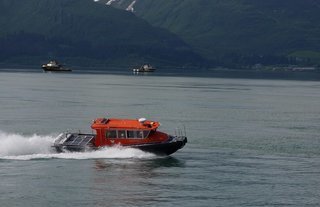Naiad Inflatables of Newport Inc. has launched three new vessels bound for Alaska and Texas, built for duty as a pilot boat, a crewboat and a whale-watching passenger vessel.
The boats underwent seatrials and delivery began in July, said Stephen Connett Jr., president of Naiad, headquartered in Portsmouth, R.I.
The new Naiad 15-meter pilot boat has twin Scania DI13 77M main engines with Twin Disc MGX-5114A gears and ZF controls. Built for the Matagorda Bay Pilots Association in Texas, the 48'x16'x5'9" boat will be the association’s primary vessel. It uses shaft propulsion, with driveline components from H&H and Michigan Wheel propellers. For coming alongside ships, the hull is ringed with Naiad’s proprietary EVA foam core fendering system with polyurea coating.
All interior and deck lighting is LED. The ship’s primary systems are 25 volt, with a voltage converter for 12VDC service. The vessel has a 3,000-watt inverter and shore power service.
In the wheelhouse are six Shockwave seats for pilots and crew during runs. Instrumentation is a top of the line G-series Raymarine package. For crew comfort there is a chart table, a small refrigerator — and for the blazing Texas summers, a 24 VDC roof mounted air conditioning for dockside service, and a Seafrost engine driven unit for use underway.
“We have seen 33 knots-plus for top speed,” Connett said.
Naiad’s 11.2-meter response/crew vessel Arctic Resolution, delivered to Arctic Response Services in Anchorage, Alaska, is powered by twin Volvo-Penta D4 300s with ZF63 Gears and HamiltonJet HJ274 waterjets. Top speed is 34 knots, and the 36'8"x10'11"x2' vessel is Coast Guard certified for 12 passengers and two crew.
The helm has a Furuno instrumentation array, with Shockwave seats for the navigator and helmsman. There is bench seating for the 12 passengers inside the cabin, with a Webasto diesel fired cabin heater. The engines are equipped with auxiliary block heaters.
Connett said this is first Naiad equipped vessel with a single point Henrikson hook system for davit launching from an offshore supply vessel. The OSV’s davit system was custom designed for the Naiad and fitted prior to the crewboat’s delivery to Alaska.
The 12.6-meter tour vessel is the first Naiad of this size to be certified for passenger use in the U.S., Connett said, but sisterships have been operating in Australia and New Zealand for over 10 years. This new 41'x13'11"x2'7" vessel will carry a certification for 40 passengers and two crew. Controls for the three Yamaha 300-hp outboards are on a large center console, which also has an interior space to accommodate a marine toilet for passengers. The 12.6 meter hull can be equipped with up to four outboards or diesel stern drives, and a similar Naiad 12.6-meter design is available specifically for diesel water jets.
The boat will take passengers on marine mammal tours less than five miles from shore. It is equipped with a small Garmin GPS/plotter, a VHF radio, stereo system, and Coast Guard-required safety gear for its inshore route.
Top recorded speed with three passengers on boat is over 46 knots. Operating speed with a full complement of passengers is expected to be 27-30 knots for optimal efficiency. Lightweight aluminum marine seating for 40 was provided by Beurteaux of Australia. The helm area has a simple leaning post for the crew.




